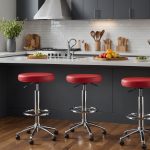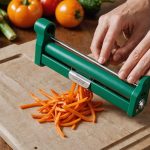Unleashing Bar Design Potential: Key Strategies for Creating Eye-Catching and Practical Spaces
When it comes to designing a bar, the goal is not just to create a space where people can grab a drink, but to craft an environment that is both visually stunning and functionally efficient. Here, we’ll delve into the key strategies for transforming your bar into a hub of activity and aesthetic appeal, using a combination of design elements, technological innovations, and marketing savvy.
The Power of Lighting: Setting the Mood and Enhancing Visibility
Lighting is one of the most critical elements in bar design, as it sets the overall atmosphere and influences customer mood and experience. There are three main types of lighting to consider: ambient, task, and accent lighting.
Also to see : Transforming customer service training in upscale dining: key strategies for excellence
Ambient Lighting
Ambient lighting creates the general mood of the space, making it intimate and relaxing, especially in fine dining settings. Dimmable fixtures allow for adjustable brightness throughout the day, enhancing the dining experience by accommodating different needs and preferences. For instance, a galaxy-inspired bar might use deep, rich blues and purples to create the illusion of infinite space, setting a cosmic and enchanting ambiance[3].
Task Lighting
Task lighting is practical, helping guests read menus and navigate the dining space without compromising aesthetics. This type of lighting ensures that the bar area is well-lit, making it easier for both customers and staff to move around comfortably.
Additional reading : Critical Safety Tips for Installing a Wood-Fired Pizza Oven in Your Restaurant: A Must-Read Guide
Accent Lighting
Accent lighting highlights specific areas or features within the bar, such as artwork, sculptures, or even the bar itself. Eye-catching lighting and vibrant colors can enhance the bar’s visibility, making it a focal point in the room. For example, LED technology can be used to create shifting nebula-like effects, transforming an ordinary bar into a breathtaking cosmic landscape[3].
Furniture Selection and Layout: Comfort and Functionality
The furniture in your bar can make or break the dining experience. Here are some key considerations:
Comfortable and Stylish Seating
Guests seek comfort and care, making comfortable and stylish seating crucial for overall satisfaction. The layout should accommodate different arrangements for diverse dining experiences, ensuring the space is both functional and aesthetically pleasing. For instance, a minimalist modern dining setup might use simple furniture with geometric shapes, while a bohemian paradise could incorporate mismatched furniture and colorful accents[5].
Bar Layout
The bar layout should facilitate smooth service for staff while enhancing the guest experience. Bar seating should blend comfort and style, ensuring ample space for guest movement. A well-thought-out furniture arrangement contributes to a positive dining experience. For example, Bar Lala inside Toronto’s Lena restaurant features a unique design where the bartender works at a table in common space rather than a traditional bar counter, creating a more interactive and welcoming environment[1].
Creating a Unique Dining Experience
A unique dining experience goes beyond good food; it’s about crafting an immersive environment that resonates emotionally with guests.
Open Kitchen Concepts
Open kitchen designs are a popular trend in modern restaurants. They allow diners to witness food preparation, increasing their investment in the meal experience. This transparency creates trust and enhances the overall dining experience. For example, seeing a chef prepare a meal can be as engaging as watching a performance, making the dining experience more interactive and memorable[1].
Feature Walls and Artistic Decor
Accent walls and artistic decor are powerful design elements that create visual interest and differentiate areas within the dining space. Well-designed accent walls enhance aesthetics and contribute to a cohesive brand experience by highlighting the restaurant’s identity. Incorporating cultural or historical elements adds depth and authenticity, fostering community connections. Personalized service and interactive elements, like cooking stations, elevate diner engagement and enjoyment[1].
Designing for Specific Areas: Entryways, Bars, and Outdoor Spaces
Each area of the bar requires tailored design strategies to enhance the dining experience.
Entryway Design
An inviting entryway uses elements that reflect the restaurant’s brand and aesthetic appeal. The design should immediately convey the restaurant’s identity and create anticipation for the dining experience. The host station’s visibility is crucial for providing a warm welcome to arriving guests. For instance, using neon signs with witty quotes or vibrant murals can create an eye-catching and shareable entryway that sets the tone for the rest of the experience[5].
Bar Area Design
The bar area is a focal point where cocktails are prepared. Eye-catching lighting and vibrant colors enhance the bar’s visibility. The bar layout should be designed to facilitate smooth service while enhancing the guest experience. Consider unique designs like a galaxy-inspired drink station, where the back wall transforms into a living galaxy with swirling blues and purples, creating a cosmic ambiance[3].
Outdoor Dining Spaces
Outdoor dining spaces need to be adaptable and inviting. Incorporate elements like nautical décor for a seaside retreat theme or use natural light and seaside-inspired props to evoke a beachside experience. The outdoor space should be as functional as it is beautiful, with careful consideration of workflow, storage, and ergonomics for smooth service[5].
Integrating Technology and Interactive Elements
Modern bar design is not just about visual aesthetics; it’s also about creating interactive experiences.
Augmented Reality and Projection Mapping
Technological innovations like augmented reality menus and projection mapping can turn your bar into a dynamic cosmic landscape. For example, an augmented reality menu that transforms when viewed through a smartphone camera can make the act of ordering a cocktail an adventure. Projection mapping can turn the bar into a living galaxy, with lighting that changes subtly throughout the evening, mimicking the movement of distant galaxies[3].
Temperature-Sensitive Surfaces and Interactive Decor
Temperature-sensitive surfaces that change color with touch and custom glassware that looks like it’s been crafted by alien civilizations can add a unique touch to your bar. Lighting fixtures designed to look like suspended planets or meteor fragments create a three-dimensional cosmic experience. These elements transform a functional space into a truly immersive experience[3].
Practical Considerations: Workflow, Storage, and Ergonomics
While the design is crucial, practical functionality cannot be overlooked.
Workflow and Ergonomics
The bar setup needs to be as efficient as it is beautiful. Work with designers who understand both the artistic vision and the practical requirements of a high-functioning bar setup. Consider workflow, storage, and the ergonomics of your bartenders. Custom shelving that looks like spacecraft components and back bars that simulate distant planetary landscapes can integrate seamlessly into your cosmic theme, ensuring smooth service[3].
Storage Solutions
Storage solutions should be integrated seamlessly into your design. For instance, using epoxy resin to create bar surfaces that look like swirling galaxies can also include hidden storage compartments. This ensures that the bar remains clutter-free and functional while maintaining its aesthetic appeal[3].
Using Coasters as a Marketing Tool
Coasters can be more than just a practical item; they can also be an effective marketing tool.
Brand Visibility
Branded coasters offer a cost-effective way to increase brand visibility. They protect tables from water marks and spills while showcasing your logo to customers. This subtle yet constant exposure can leave a lasting impression and reinforce your brand identity. For example, custom-printed coasters with your logo can be used in both the bar and outdoor dining areas, ensuring consistent branding across all spaces[4].
Target Audience Engagement
Coasters can be tailored to engage your target audience. For instance, beer coasters with witty quotes or themed designs can appeal to beer enthusiasts, making them more likely to share their experience on social media. This can create buzz around your brand and attract potential customers who are drawn to the unique and engaging atmosphere of your bar[4].
Table: Comparing Different Bar Design Themes
| Theme | Ideal For | Vibe | Key Elements |
|---|---|---|---|
| Minimalist Modern | High-end restaurants, sushi bars | Clean, elegant, uncluttered | Neutral tones, simple furniture, geometric shapes, single piece of standout artwork[5] |
| Bohemian Paradise | Vegan cafés, artisan bakeries, coffee shops | Relaxed, artsy, eclectic | Patterned rugs, macramé wall hangings, mismatched furniture, hanging plants, fairy lights[5] |
| Retro Diner | Fast-food joints, ice cream parlors, burger diners | Nostalgic, fun, vibrant | Checkerboard flooring, vinyl booths, neon signs, jukeboxes, vintage posters[5] |
| Art Deco Elegance | Fine dining restaurants, cocktail lounges | Luxurious, glamorous, refined | Geometric patterns, metallic tones, rich colors, velvet chairs, marble surfaces, dramatic chandeliers[5] |
| Galaxy-Inspired | Trendy bars, cosmic-themed venues | Cosmic, enchanting | Deep blues and purples, LED technology, epoxy resin bar surfaces, custom glassware, projection mapping[3] |
Effective Marketing Strategies: On-Demand and Guerrilla Marketing
In addition to design, effective marketing strategies can further enhance your bar’s appeal.
On-Demand Marketing
On-demand marketing involves delivering real-time, personalized solutions and targeted content to meet customer needs as they happen. This can include analyzing consumer behavior across different platforms to focus on overlooked markets and increase reach. For example, if your customers want to see outfits put together in advance, you can create triggers throughout the buyer’s journey to influence purchasing decisions. This approach can be applied to your bar by offering personalized drink recommendations based on customer preferences and behavior[2].
Guerrilla Marketing
Guerrilla marketing involves using unconventional tactics to capture attention. For a bar, this could mean creating interactive experiences or hosting themed nights that generate buzz on social media. For instance, a galaxy-themed night with augmented reality menus and projection mapping can create a memorable experience that customers will share online, attracting new potential customers to your bar.
Creating an eye-catching and practical bar space is a multifaceted endeavor that involves careful consideration of lighting, furniture, technology, and marketing strategies. By integrating these elements seamlessly, you can transform your bar into a hub of activity and aesthetic appeal that leaves a lasting impression on your customers.
As one designer noted, “A truly exceptional bar is more than just a design – it’s a narrative. It creates moments of wonder, sparks conversations, and transforms an ordinary night into an extraordinary journey.”[3]
By focusing on the key strategies outlined here, you can unleash the full potential of your bar design, creating a space that is both beautiful and functional, and that resonates deeply with your customers. Whether you’re aiming for a minimalist modern look or a galaxy-inspired cosmic experience, the right combination of design and marketing can make your bar a standout destination.











